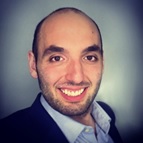
Entrepreneurial Fellow
University of Glasgow
Dates: 04/2011 – 07/2012
Partner University: Stanford University
Partner University Collaborator: Prof. Martin Fejer
Background
My 16-month fellowship was titled “Investigating the atomic structure and properties of amorphous dielectric materials to aid in the development of dielectric coatings of low mechanical and optical loss.” A number of optical applications are critically dependent on highly reflective mirrors of low optical and/or mechanical loss, including ring laser gyroscopes in inertial guidance systems, and frequency stabilization using laser cavities relevant to e.g., frequency comb techniques, and high precision interferometers for gravitational wave detection such as the Laser Interferometer Gravitational-wave Observatory (LIGO). The research conducted during this fellowship established the development of experimental techniques that measure the material properties of test coatings at the atomic scale and use the information obtained to inform the development of new coatings with improved macroscopic properties. Between April 2011 and July 2012, a total of 4 months was spent working at the University of Glasgow and 12 months as a Visiting Scholar at Stanford University.
Objectives
My key objectives for this fellowship were:
- Build, develop and maintain a coatings materials characterization research program at Stanford
- Continue to work closely with collaborators at the University of Glasgow
- Explore and establish a network within relevant Bay Area and Scottish industries
Achievements and Impacts
Two key areas of research were undertaken. Firstly, through studying the short-range atomic structure by obtaining reduced density functions (RDFs) using Transmission Electron Microscopy, where the first direct correlations between atomic structure and mechanical loss were observed for tantala (Ta2O5) coatings. Secondly, I led a research project at the Stanford Synchrotron Radiation Lightsource (SSRL), where X-ray absorption spectroscopy (XAS) was used to study the atomic structure of the coatings around specific atomic species, such as tantalum and titanium.
Researching at Stanford University as an SU2P Entrepreneurial Fellow has been an amazing experience. Stanford University and the wider San Francisco Bay Area is an inspiring place to live and work, with its unique innovative culture and endless opportunities to interact and work with some of the world’s brightest minds. Coating atomic structure research carried out during my fellowship gave the opportunity to interact with many of SU2P’s industrial partners, both in Scotland and near Stanford. I have provided advice and discussed coating materials properties with employees of many companies, including: Advanced Thin Films, Continuum, Coherent, Helia Photonics, IPG Photonics, MLD Technologies, PowerPhotonic and Spectra-Physics.
I now have a large and active network of contacts in the coatings and photonics industries, which has given me a strong appreciation of these industries, their requirements, and the potential for working together in collaborative research projects. I regard this is an important part of my research career, which will enable enhanced broader impact of my research.
Outputs
View Riccardo's outputs in our bibliography section
04/11 - 07/11
SU2P Fellowship, Glasgow University
07/11 - 07/12
SU2P Fellowship, Visiting Scholar at Stanford University
08/12 - 01/15
Postdoctoral Scholar, Stanford University
01/15 - Present
Research Scientist (Academic Staff), Stanford University